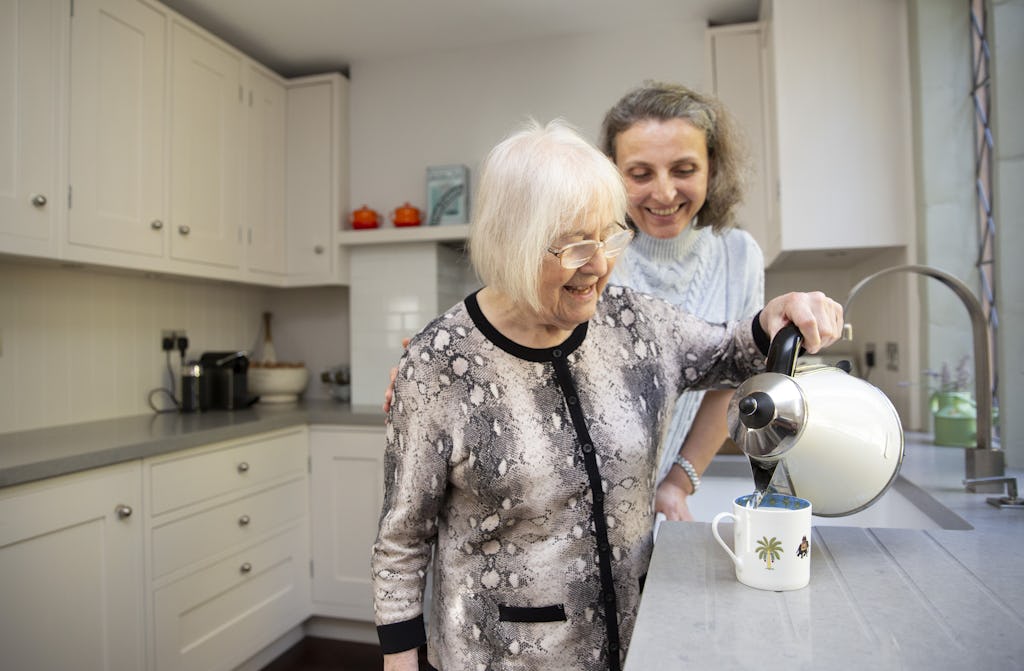Live-in Care Hub’s findings on residential and nursing care
At Trinity Homecare, we believe that live-in care is a great and cost-effective alternative to residential and nursing care. As members of the Live-in Care Hub, we have first-hand access to the latest Better at Home Report which supports the notion that live-in care is an equally effective form of care, if not better. Some of the findings from the report show how live-in care is becoming a huge part of the future of care and how ideas around freedom, safety, and happiness remain a prominent decision-making factor.

How care is evolving from residential and nursing care
Residential and nursing care homes have been the traditional form of care that most people turn to when seeking full-time support for a loved one. However, during recent years, care at home has become more widely available and accepted in the UK.
In fact, since the pandemic, care at home has been highlighted as a far safer, cost-effective and more dignified type of care with much evidence to back this.
The COVID-19 pandemic has affected us all in many ways. COVID-19 has posed a risk to every individual’s health and general wellbeing. However, there appears to be a higher risk of infection rates in care homes in the past 12 months due to the government’s strategy of hospital discharges, use of PPE, and testing.
Despite efforts of staff in care homes, elderly and vulnerable adults residing in care homes have faced the brunt, isolated from seeing loved ones and family and at a higher risk of contracting COVID-19. As a consequence, live-in care and other types of care at home have become more widely accepted.
Freedom, safety and happiness at home
Independent regulator of Health and Social Care in England, the Care Quality Commission (CQC) rates care providers based on whether they are “safe, effective, caring, responsive and well-led”. Forming part of these key factors include the freedom, safety and happiness of those receiving care.
Freedom in residential and nursing care homes
In the UK, many of us have a love for animals and consider our pets part of the family. Sadly, it has been revealed that in more than half of all care and nursing homes, pets are not allowed. This very often means that pets are put to sleep or that the individual and pet never see one another again.

The Better at Home Report also found that in a quarter of the care and nursing homes surveyed, “residents were not allowed out of the grounds for a walk” which is considered a serious restriction of their basic right to liberty.
With live-in care, the carer isolates alongside the client and is able to ensure that they have the freedom to get their daily exercise or enjoy the things they usually would, like taking the dog for a walk. With live-in care there are no restrictions on freedom.
Saftey in residential and nursing care homes
Arguably, safety is one of the most important things to consider when deciding on care solutions.
The Better at Home Report found that with live-in care, there are “half as many hip fractures compared to residential care and nursing homes.”
According to the Royal College of Physicians, “hip fracture patients face a significant risk of dying or losing their independence”.
During the pandemic, it was also found that the rate of death from Coronavirus in care and nursing homes is approximately 7,136 in 100,000, whereas the rate for live-in care was only 1,482 in 100,000. This means there is around 6 times more chance of dying of coronavirus in a care or nursing home than there is when receiving live-in care.
Members of the Homecare Association and Live-in Care Hub, such as ourselves, have had access to quality PPE with guidance to mitigate the risk of transmission of Coronavirus.
Happiness at home
There are several reports that show those who receive care at home are far happier. Individual case studies through the Live-in Care Hub and Trinity Homecare demonstrate that individuals are able to live happily and comfortably in their own homes with the support they require.
Cost of residential and nursing care vs live-in care
The cost of live-in care are at a comparable cost to that of residential and nursing care homes. The Better at Home Report found that whilst the price of live-in care costs a very similar amount of £900 -£1,500 a week, live-in care offers one-to-one support which is highly valuable. The hours of care received is also considerably more, meaning you get your money’s worth.
Find out more about Live-in Care today
You may have never thought about live-in care as an option until now. If you would like to find out more about our ‘Outstanding’ rated live-in care service, then book a call with one of our Care Specialists today to see how we can help.








